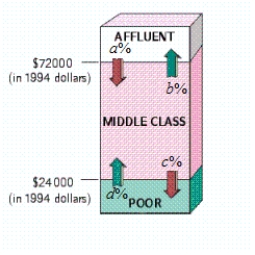The following diagram shows the movement of U.S. households among three income groups - affluent, middle class, and poor - over the 11-year period 1982-1993. Assuming that the trend shown was to continue, what percent of households classified as affluent in 1982 were predicted to become poor in 2004 (Give your answer to the nearest .) According to the model, what percentage of all U.S. households will be in each income bracket in the long term (Give your answer to the nearest percent.)  , , ,
, , ,
A) 0.3% of households classified as affluent in 1982 were predicted to become poor in 2004. In the long term: Affluent: 22.7%; Middle class: 36.3%; Poor: 41.1%
B) 0% of households classified as affluent in 1982 were predicted to become poor in 2004.
In the long term: Affluent: 26.5%; Middle class: 8.1%; Poor: 65.4%
C) 0% of households classified as affluent in 1982 were predicted to become poor in 2004.
In the long term: Affluent: 18.9%; Middle class: 64.4%; Poor: 16.7%
D) 0.3% of households classified as affluent in 1982 were predicted to become poor in 2004.
In the long term: Affluent: 26.5%; Middle class: 8.1% ; Poor: 65.4%
E) 2.1% of households classified as affluent in 1982 were predicted to become poor in 2004.
In the long term: Affluent: 26.5%; Middle class: 8.1%; Poor: 65.4%
Correct Answer:
Verified
Q10: Write down the transition matrix associated
Q11: You are given a transition matrix
Q12: The following diagram shows the movement
Q13: Tommy the dunker's performance on the
Q14: Adoptions College instructors who adopt this
Q16: You are given a transition matrix
Q17: A University of Kansas study shows
Q18: You have worked for the Department of
Q19: In an experiment to test the effectiveness
Q20: A market survey shows that one
Unlock this Answer For Free Now!
View this answer and more for free by performing one of the following actions

Scan the QR code to install the App and get 2 free unlocks

Unlock quizzes for free by uploading documents